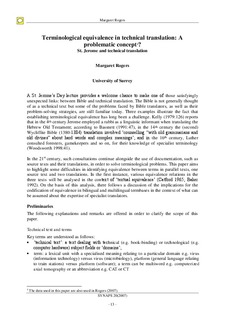| dc.description.abstract | A St. Jerome’s Day lecture provides a welcome chance to make one of those satisfyingly
unexpected links: between Bible and technical translation. The Bible is not generally thought
of as a technical text but some of the problems faced by Bible translators, as well as their
problem-solving strategies, are still familiar today. Three examples illustrate the fact that
establishing terminological equivalence has long been a challenge. Kelly (1979:126) reports
that in the 4th century Jerome employed a rabbi as a linguistic informant when translating the
Hebrew Old Testament; according to Bassnett (1991:47), in the 14th century the (second)
Wycliffite Bible (1380-1384) translation involved ‘counselling “with old grammarians and
old divines” about hard words and complex meanings’; and in the 16th century, Luther
consulted foresters, gamekeepers and so on, for their knowledge of specialist terminology
(Woodsworth 1998:41). | nb_NO |
